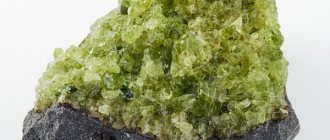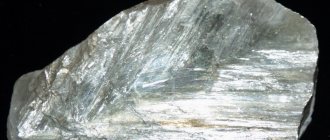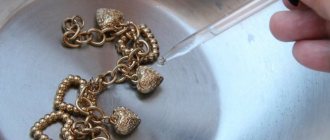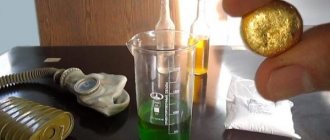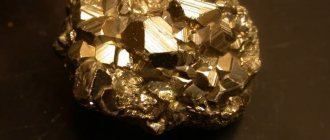The widespread use of gold in industrial production is due to the chemical and physical properties of the noble metal. The jewelry industry is the main consumer of the material, but science has discovered other possibilities for the precious metal besides making jewelry. Gold has found its application in medicine, the food industry, cosmetology, and in the manufacture of the finest parts for machinery and equipment.
Brief description of metal properties
Gold is the most attractive, solar chemical element belonging to the group of precious and rare metals. In addition to its physical and chemical properties, its value is given by a wide range of applications in various industries, and in the foreign exchange market of precious metals, gold has firmly established its primacy.
Initially, gold was used to make jewelry, and later coins were minted from it. Today solar metal is used as:
- funds for capital investment;
- raw materials for industrial production of parts, components, microelements;
- material used in medicine, including dentistry;
- catalysts in the petrochemical industry;
- raw materials for the jewelry industry.
The active use of gold in industrial production is associated with its physical parameters:
- ductility;
- ductility;
- electrical conductivity;
- thermal conductivity;
- corrosion resistance;
- plastic;
- ability to reflect the infrared spectrum of radiation.
Industrial uses of metal
The demand for gold for industry is several hundred tons per year. A larger amount of the material is used in the electronics industry, where it is used to make parts for cell phones, computers and household appliances.
The ability of the material to reflect radiation (ultraviolet, infrared) allows it to be used as a coating for spacecraft and satellites.
As an additive that improves the physical and chemical parameters of a product, gold is used in the manufacture of special types of glass for portholes. A thin layer of material applied to the inside of the window glass significantly reduces heat loss in winter and protects against overheating in summer.
In the chemical industry, it is used as a catalyst and for the manufacture of parts that need to be resistant to external conditions. Recent studies have established the feasibility of using gold in the fuel system of cars.
The special property of the material to conduct heat well is used when applying protective coatings to parts. In watch production, cases are gilded using the galvanic method.
The property of gold solder to perfectly wet surfaces of different metals allows it to be used for soldering. Gold is used to make threads, and thin plates are used to cover artistic products.
Industrial demand for gold is relatively stable. In terms of its technical use, the market leaders are the USA, Japan and Germany, where the metal is used in technological processes associated with instrument making, the manufacture of parts for jet engines, spacecraft, and nuclear reactors.
In the dynamics of demand for gold for industrial production over 15 years, the peak occurs in 2007, in which global industrial demand reached 477 tons. The lowest consumption was in 2015 and amounted to 331 tons.
Applications of gold
The gold currently available in the world is distributed as follows: about 10% is in industrial products, the rest is divided approximately equally between centralized reserves (mainly in the form of standard bars of chemically pure gold), private property in the form of bars and jewelry.
As an investment object
Graph of changes in the price of gold from 2000 to 2010 - displays the PM Fixing spot price for gold on the London Metal Exchange (LME)
In 2005, Rick Munarriz asked the question: what is more profitable to invest in - Google, which owns the search engine of the same name, or gold. At that time, the cost of 1 Google share and 1 ounce of gold on the stock exchange was the same. At the end of 2008, trading in Google closed at $307 per share, and in gold at $866 per ounce. The result of this operation highly depends on the choice of starting and ending points of comparison.
Gold is the most important element of the global financial system, since this metal is not subject to corrosion, has many technical applications, and its reserves are small. Gold was practically not lost during historical cataclysms, but was only accumulated and melted down. Currently, the world's bank reserves of gold are estimated at 32 thousand tons (if you fuse all this gold together, you will get a cube with a side of only 12 m).
The declining role of gold as an international currency has been repeatedly emphasized, however, almost all banks in the world hold gold as a source of liquidity. Thus, according to data for 2007, central banks kept about 20% of all world reserves of mined gold as reserve assets, while individual countries kept about 10% of their reserves in gold[18].
Gold has long been used by many peoples as money. Gold coins are the best-preserved antiquities. However, gold coins were established as a monopoly monetary commodity only by the 19th century. Until World War I, all world currencies were based on the gold standard (the period 1870–1914 is called the “golden age”). At this time, paper bills played the role of certificates of gold. They were freely exchanged for gold.
In industry
In terms of its chemical resistance and mechanical strength, gold is inferior to most platinum group metals, but is irreplaceable as a material for electrical contacts. Therefore, in microelectronics, gold conductors and gold electroplating of contact surfaces, connectors, and printed circuit boards are used very widely.
Gold is used as a target in nuclear research, as a coating for mirrors operating in the far infrared range, and as a special shell in a neutron bomb.
Gold solders wet various metal surfaces very well and are used in metal soldering. Thin gaskets made from soft gold alloys are used in ultra-high vacuum technology.
Gilding of metals (in ancient times it was exclusively an amalgam method, nowadays it is mainly galvanic) is widely used as a method of protection against corrosion. Although this coating of base metals has significant disadvantages (softness of the coating, high potential for pitting), it is also common due to the fact that the finished product takes on a very expensive, “golden” appearance.
Gold is registered as a food additive E175.
In jewelry
The traditional and largest consumer of gold is the jewelry industry. Jewelry is made not from pure gold, but from its alloys with other metals, which are significantly superior to gold in mechanical strength and durability. Currently, Au-Ag-Cu alloys are used for this, which may contain additives of zinc, nickel, cobalt, and palladium. The corrosion resistance of such alloys is determined mainly by their gold content, and the color shades and mechanical properties are determined by the ratio of silver and copper.
The most important characteristic of jewelry is its fineness, which characterizes the gold content in it.
In dentistry
Dentistry consumes significant amounts of gold: crowns and dentures are made from alloys of gold with silver, copper, nickel, platinum, and zinc. Such alloys combine corrosion resistance with high mechanical properties.
In pharmacology
Gold compounds are included in some medications used to treat a number of diseases (tuberculosis, rheumatoid arthritis, etc.). Radioactive gold is used in the treatment of malignant tumors.
Application of metal in medicine and food industry
A significant amount of noble material is consumed by dentistry for the manufacture of dentures and crowns. Gold has become important in the medical research industry, needed to improve tools and drugs used in the treatment of arthritis, cancer and other diseases.
In cosmetology, gold is used for the purpose of rejuvenation. “Cleopatra's Mask,” proposed by Japanese experts, contains sheets of 24-karat metal. Gold foil is applied to the face and, reacting with the skin, enhances the production of collagen and elastin, due to which renewal and rejuvenation occurs.
Metallic gold, the use of which in the food industry is permitted in many countries, is food coloring E-175. Used in the production of alcoholic beverages. When illuminated, the contents of the bottle create a perfect play of light and shadow. It is also known to use thin edible gold foil.
Industry Applications of Gold
The bulk of the mined gold is stored in the form of bars and coins in state funds, making up the so-called “gold reserve”, which serves as collateral and currency for international payments and settlements.
The rest of the mined gold is used:
— in the manufacture of jewelry (50%);
— in industry: gilding of metals (electroplating - electrolysis with complex salt KAu(CN2));
— radio electronics;
— chemical industry;
- production of porcelain products in the form of paint or so-called “gilding” (55%);
- medicine - 10% (dentistry), radioactive gold (usually 198Au) helps diagnose tumors.
In recent years, gold has been widely used in new technology as a welding material, for the manufacture of thermocouples, hairs of chronometers and galvanometers, and for coating the surface of spacecraft (to reflect heat and light).
As an investment object
Gold is the most important element of the global financial system, since this metal is not subject to corrosion, has many technical applications, and its reserves are small.
Gold was practically not lost during historical cataclysms, but was only accumulated and melted down. Currently, the world's bank reserves of gold are estimated at 32 thousand tons (if you fuse all this gold together, you will get a cube with a side of only 12 m).
Gold has long been used by many peoples as money.
Gold coins are the best-preserved antiquities.
However, it only became established as a monopoly monetary commodity in the 19th century. Until World War I, all world currencies were based on the gold standard (the period 1870–1914 is called the “golden age”).
At this time, paper bills served as proof of the presence of gold. They were freely exchanged for gold.
Rising gold prices In 1944, the official price of $35 per troy ounce of gold (31.1 g) was approved; by 1961, this price increased to $42.2, and in 1980 it reached a maximum of $608 per ounce of gold. ($19.5 per gram).
With short-term surges in demand, the price rose to $850 per ounce.
The increase in demand for gold and its price was reflected in the increase in its global production from 1980 to 1991 from 1250 tons to 2116 tons.
Increased production led to a drop in its value from $14/year in 1988 to about $9/year in 1999.
Despite a slight decrease in gold production in 1994-1995. its consumption is constantly increasing due to increasing use by the jewelry industry, electronics and hoarding.
The decline in gold prices was due to large sales of gold by the Central Banks of a number of countries and the monetary and financial crisis in the countries of the Asia-Pacific region - the largest buyers of gold.
Gold prices on the world market have fluctuated in recent years from 12.5 to 8.4 dollars per year, with a cost of about 7.65 dollars per year.
Today, the world market is experiencing a rapid rise in gold prices.
Prices for this precious metal are breaking all imaginable and unimaginable records, updating their historical highs almost every day.
Experts say that there are now plenty of fundamental reasons for the rise in gold prices.
This is the weakness of the American currency, and the growth of inflation expectations, and the purchase of gold by Asian Central Banks.
It should not be forgotten that gold is often perceived as insurance against inflation and currency risks. It is not surprising that against the backdrop of instability in world markets, the yellow metal is in high demand.
The weakening of the dollar also played an important role.
Chart from citizensbankdelphos.com.
In industry
In terms of its chemical resistance and mechanical strength, gold is inferior to most platinum group metals, but is irreplaceable as a material for electrical contacts.
Therefore, in microelectronics, gold conductors and gold electroplating of contact surfaces, connectors, and printed circuit boards are used very widely.
Gold is used as a target in nuclear research, as a coating for mirrors operating in the far infrared range, and as a special shell in a neutron bomb.
Gold solders wet various metal surfaces very well and are used in metal soldering.
Thin gaskets made from soft gold alloys are used in ultra-high vacuum technology.
Gilding of metals (in ancient times it was exclusively an amalgam method, nowadays it is mainly galvanic) is widely used as a method of protection against corrosion. Although this coating of base metals has significant disadvantages (softness of the coating, high potential for pitting), it is also common due to the fact that the finished product takes on a very expensive, “golden” appearance. Gold is registered as a food additive E175.
In jewelry
The traditional and largest consumer of gold is the jewelry industry.
Jewelry is made not from pure gold, but from its alloys with other metals, which are significantly superior to gold in mechanical strength and durability. Currently, Au-Ag-Cu alloys are used for this, which may contain additives of zinc, nickel, cobalt, and palladium.
The corrosion resistance of such alloys is determined mainly by their gold content, and the color shades and mechanical properties are determined by the ratio of silver and copper.
In dentistry
Dentistry consumes significant amounts of gold: crowns and dentures are made from alloys of gold with silver, copper, nickel, platinum, and zinc.
Such alloys combine corrosion resistance with high mechanical properties.
In pharmacology
Gold compounds are included in some medications used to treat a number of diseases (tuberculosis, rheumatoid arthritis, etc.). Radioactive gold is used in the treatment of malignant tumors.
Use of gold: in industry and cooking, medicine and cosmetology
The use of gold in industry is determined by the qualities of the metal
Gold is an ancient metal of wealth, commerce and beauty, but it also has a number of unique properties that make it invaluable to industry.
These properties include:
- corrosion resistance
- electrical conductivity
- plasticity and malleability
- infrared (thermal) reflections
— thermal conductivity.
Gold's excellent electrical conductivity, ductility and corrosion resistance have made the metal a vital component used in a wide range of electronic products and equipment, including computers, telephones, cell phones and home appliances.
Gold is extremely reflective (shielding), which protects spacecraft and satellites from solar radiation (using gold as a coating to focus and reflect light energy).
Due to the fact that gold is biologically inactive, it has become a vital tool for medical research and is even used in the direct treatment of arthritis and other diseases.
And of course, gold is widely used in dentistry - for the manufacture of dentures and crowns.
Due to its resistance to corrosion, gold is used in the chemical industry - for the manufacture of parts for devices and as a catalyst.
Gold is a refractory metal; the melting point of gold is 1064.43°C.
Industrial demand for gold is stable and growing.
The supply of gold from stored reserves and produced gold mines is and will remain so. Demand from investors who want to own this precious metal is steady, and increases during periods of global crises and instability. As a result, the gold investment market has great growing potential.
Gold is an excellent hedge against inflation and protects future income.
Modern investors can invest in gold in the traditional way - by purchasing gold in the form of bars or coins. Or they can trade gold or gold futures electronically.
Investing in companies involved in gold processing is also profitable.
Use of gold in medicine
How is gold consumed? About 75% of the gold produced in mines in the world goes into jewelry production. This is the first meaning of the term consumption. Even more amazing are the other ways in which gold actually finds its way into the human body.
Gold and medicine
The use of gold in medicine in the field of dentistry is widely known.
It is believed that gold crowns are the best. Although cheaper alternatives are rapidly emerging, high-gold amalgam dental fillings remain the most desirable. Gold is a soft metal, and its use in a crown reduces stress on the opposing teeth during the chewing process. Modern porcelain crowns are much more fragile than gold and less durable.
Gold crowns can last for several decades; any other material cannot compare with gold in strength and durability.
Gold has other medical uses. The isotope of gold, 198 Au, which has a half-life of 2.7 days, is used in the treatment of some cancers and other diseases, and as a tracer in the human body.
Compounds containing gold are used in injections to treat arthritis. Auranofin, a complex of complex organic molecules, is used to treat some cases of rheumatoid arthritis. Although consuming gold in small quantities is essentially harmless, gold can be toxic, as is known from its use in treating arthritis. Skin rash is the most common side effect resulting from excessive consumption of gold for medicinal purposes.
Gastrointestinal disorders may also be present from time to time as a result of excessive consumption of the gold compound.
Gold in cosmetology
Golden mask (“Cleopatra’s mask”) at home
The magic of gold. A revolutionary method of rejuvenation.
It is known that gold has various magical and rejuvenating properties, so it has been used in cosmetology since ancient times.
The use of external remedies based on gold is described in ancient Chinese medical treatises.
The Golden Mask is a treatment for the face, neck and décolleté, proposed by Japanese specialists. It is based on the use of gold sheets. For the manufacture of such sheets, 24-karat (or 99.9%) gold is used - ideally pure gold that does not contain any additives or impurities.
This is a completely new recipe for rejuvenation and healing of problem areas of the skin. And for this you do not need to implant gold under the skin using surgical methods (implantation of gold threads is a gentle, but still surgical intervention).
Therefore, we can safely say that the use of gold sheets (foil) is an excellent alternative to a rejuvenating procedure using gold threads.
Applying a pure gold mask at home.
Although this procedure is classified as a luxury anti-aging procedure, the Golden Mask can be done independently at home.
When using gold foil, gold ions react with the skin and accumulate on weakened problem areas, restoring the natural balance in these places. At the same time, skin turgor improves, it is intensively moisturized, swelling and pigmentation are reduced, and the procedure has a lifting effect.
In addition, the use of the Golden Mask enhances the production of elastin and collagen, accordingly the skin is renewed and rejuvenated.
Before applying the mask, it is necessary to clean and steam the skin of the face and neck area; do not use cleansers containing oils and acids. If there are scratches or wounds on the skin, undergo a rejuvenating procedure. Apply the mask with dry hands and only on clean, well-moisturized skin. The duration of the procedure is no more than half an hour; for the best effect, you need to place a damp towel on top of the mask.
After removing the foil, the remaining gold particles should be rubbed into the skin and moisturized with cream.
One procedure per week for a month is enough, the result lasts for a long period. Now the Golden Mask - a procedure for VIP clients of famous beauty salons and SPA centers in the USA and Europe - is available at home.
Gold and cooking
"Serve gold" at a party.
Gold in the form of very thin leaves (several atoms thick) is added to certain liqueurs from Eastern Europe, such as Goldwasser liqueurs.
This gives a liquid shine in glass bottles; when light hits these “golden leaves”, an incomparable picture is created. Pure gold leaf has a long tradition of use in cuisine in both Europe and the Far East. Exotic dishes are wrapped in 99.9% gold leaf, so thin that the gold itself becomes edible.
Gold mining process, mining methods, gold shortage
Jewelry industry
The main segment of world production where gold is used is the jewelry industry, for which the noble material is the most valuable and most applicable in the manufacture of jewelry.
Throughout human history, solar metal has been a symbol of wealth and prosperity. The only thing that changes in relation to it is the ability to improvise with alloys and the combination of the colors of the precious material in one piece of jewelry.
Analysis of data on the average annual demand for gold indicates that the jewelry industry accounts for more than half of the total. Consumption of the Indian jewelry industry accounts for 25% of global demand.
Alloys are used in the jewelry industry. Depending on the composition of the alloy, the material acquires new properties that determine its resistance to corrosion and color shades. There are yellow, white and red gold.
The fashion for solar metal is not going away. Customer demand is formed depending on the assortment and design of jewelry, skillful combination of material and stones. Masterpieces of jewelry made from alloys guarantee the strength and reliability of the product during operation.


